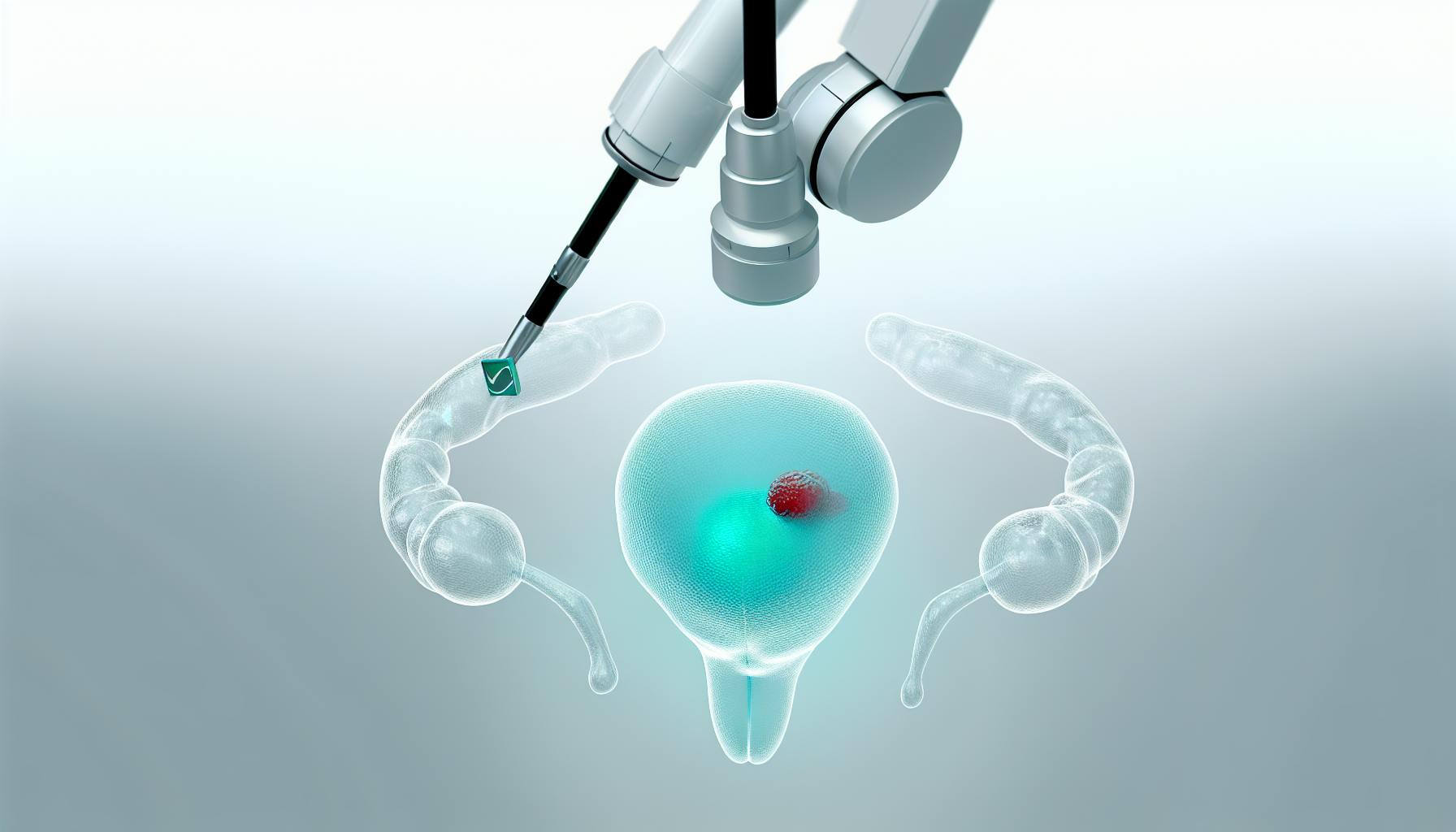Most readers would agree that achieving precision in complex urologic procedures can be extremely challenging through traditional open or laparoscopic surgery.
Robotic surgical systems provide enhanced precision and control that can lead to better outcomes in urologic procedures ranging from prostatectomy to adrenalectomy.
In this article, we will explore how robotic surgery enables unparalleled precision in urologic healthcare, leading to reduced complications, quicker patient recovery, and potentially improved quality of life after surgery.
Embracing Enhanced Precision with Robotic Surgery in Urology
Robotic surgery has brought a new level of precision and control to complex urologic procedures. By providing surgeons with superior visualization, dexterity, and ergonomics compared to traditional open or laparoscopic techniques, robotic platforms like the da Vinci Surgical System have the potential to lead to better outcomes, shorter hospital stays, less pain, and faster recovery times for patients.
Defining Robotic Surgery and Its Place in Modern Healthcare
Robotic surgery refers to a minimally invasive surgical procedure performed using a computer-controlled robot. Rather than directly manipulating surgical instruments, the surgeon sits at a console viewing a magnified, high-definition 3D image of the surgical site. Hand movements are translated to precision movements of tiny instruments mounted on robotic arms.
This approach brings unique advantages:
- Enhanced visualization and access to anatomy
- Greater range of motion and control than human hands
- Tremor filtering for extremely steady instrument control
- Ergonomic surgeon posture at console
Robotic surgery has seen rapid adoption since FDA approval in 2000. Over 6 million robotic procedures have been performed, with urologic surgeries representing a large percentage.
Comparative Advantages: Robotic Surgery vs Laparoscopic Techniques
While laparoscopic surgery marked a major advancement over traditional open surgery, robotic techniques offer comparative benefits:
- 10x magnification and 3D imaging vs 2D laparoscopic view
- Wristed instruments for 270° articulation vs limited laparoscopic movement
- Superior ergonomics and reduced fatigue for surgeon
- Enhanced control and precision in confined spaces
- Shorter learning curve for surgeons
Studies show robotic prostatectomy is associated with lower risk of complications, less blood loss, and shorter hospital stay compared to laparoscopic prostatectomy.
The Surgeon's Perspective: Ergonomics and Control
The ergonomic design of robotic consoles allows surgeons to operate in a comfortable, seated position with eyes, hands and body positioned for optimal efficiency. This contrasts with awkward postures often required during lengthy minimally invasive procedures.
Hand tremors are also eliminated as movements are filtered and scaled down by the robotic system. This gives the surgeon unwavering control and precision when operating in tight spaces or suturing delicate tissues - critical advantages during complex reconstructive procedures.
Patient-Centric Benefits: Quicker Recovery and Reduced Trauma
While surgical outcomes rely greatly on surgeon technique and experience, robotic approaches offer inherent patient benefits:
- Less pain and scarring due to smaller incisions
- Low risk of infection and less blood loss
- Shorter hospital stays and faster recovery/return to normal activities
- Reduced risk of sexual or urinary dysfunction after prostate surgery
Patients can be reassured knowing robotic techniques provide a less invasive option without compromising cancer control or outcomes.
Robotic Surgery: A Paradigm Shift in Urologic Procedures
Within urology, robotic surgery has revolutionized procedures like radical prostatectomy and partial nephrectomy over the past two decades. What began as an emerging technology has become the standard of care for urologic cancers at many leading hospitals.
Robotic techniques will continue advancing access and outcomes for complex urologic conditions. Surgeons specializing in robotic surgery can offer patients a truly minimally invasive approach with unparalleled visualization, control, and precision.
Why are robots better at surgery?
Robotic surgery offers several key advantages over traditional open or laparoscopic surgery:
Enhanced Precision and Control
The robotic surgical system allows for greater precision and control compared to human hands. The robotic arms have wrists with a full range of motion, eliminating the natural hand tremor of surgeons. This allows for incredibly precise movements and micromanipulation of tissue. Surgeons can make smaller, more accurate incisions that lead to less pain, scarring, and faster recovery times.
3D Magnified High Definition Visualization
The robotic console provides a crystal clear, highly magnified 3D view of the surgical site with up to 10x magnification. This allows the surgeon to vividly see anatomy like blood vessels and nerves to avoid damage.
Less Blood Loss and Need for Transfusions
Due to the precision of robotic tools, there is generally less blood loss during surgery. This reduces the need for blood transfusions and related risks.
Faster Recovery Time
With smaller incisions, less pain, and less blood loss, patients typically recover faster after robotic procedures vs open or laparoscopic surgery. Most patients can go home within 24 hours after surgery.
In summary, robotic surgical systems offer enhanced surgical capabilities that simply exceed human limitations. This leads to better outcomes for complex urologic conditions.
Does robotic surgery have better outcomes?
Robotic surgery has been shown to produce outcomes that are at least as good as, and in some cases better than, comparable laparoscopic procedures. Here are some of the key benefits of robotic surgery in terms of outcomes:
Enhanced Precision and Control
The robotic surgical system allows surgeons to operate with enhanced precision, dexterity, and control compared to traditional open or laparoscopic techniques. The wristed instruments and 3D high-definition visualization system give surgeons a greater range of motion and visual clarity when operating. This level of precision can lead to better outcomes.
Shorter Hospital Stays
Multiple studies have found that patients who undergo robotic surgery typically have shorter hospital stays following surgery compared to open or laparoscopic approaches. Shorter hospital stays suggest faster recovery times.
Less Blood Loss and Transfusions
Robotic techniques have been associated with reduced blood loss and lower transfusion rates for certain urologic procedures like prostatectomy. Minimal blood loss allows patients to recover faster.
Faster Return to Normal Activities
Some analyses show patients return to daily activities more quickly after robotic surgery compared to open or laparoscopic surgery. Quicker return to normal routines indicates patients are recovering well.
So in many areas, robotic surgery has demonstrated improved or comparable outcomes to other minimally invasive and open surgical approaches. The technology continues to be refined and outcomes studied, but the benefits are clear for many urologic conditions.
Do you heal faster with robotic surgery?
With robotic procedures, hospital stays and recovery times are typically shorter. Patients often return to normal function quicker than with standard open or laparoscopic surgery for several key reasons:
-
Enhanced precision and control with robotic instruments allows surgeons to operate through smaller incisions with less trauma to surrounding tissues. Smaller incisions mean less pain, bleeding, and risk of infection post-surgery.
-
The magnified 3D visualization gives surgeons a detailed view of anatomy, enabling more meticulous dissections and reconstructions. This leads to less collateral damage and faster healing.
-
Robotic systems have instruments with multiple degrees of freedom, mimicking the motion of a human wrist. This facilitates complex maneuvers in tight spaces that would otherwise require larger incisions.
So in short - yes, patients do tend to heal faster with robotic surgery compared to open or laparoscopic approaches. The technology allows skilled surgeons to operate with more finesse through tiny incisions. This reduces surgical trauma and complications, helping patients get back on their feet sooner.
sbb-itb-89ec482
Why robotic surgery is better than the traditional way?
Robotic surgery offers several key advantages over traditional open surgery or laparoscopic surgery.
Smaller Incisions
The small, wristed instruments allow for tiny incisions, rather than large cuts through muscle. This results in significantly less pain, bleeding, and scarring for patients.
Enhanced Precision
The robotic console gives surgeons a high-definition 3D view inside the patient's body and allows for enhanced precision and control when operating. This leads to better outcomes and fewer complications.
Shorter Recovery
With smaller incisions, less trauma to the body, and faster healing times, most robotic surgery patients can go home from the hospital much sooner and return to normal activities more quickly.
In summary, robotic surgery represents an important evolution in surgical technology. The improved visualization, precision, dexterity and control offered by the robotic platform can lead to better patient outcomes for many procedures. Patients typically experience less pain, faster recovery times, shorter hospital stays, less scarring and fewer complications compared to open or laparoscopic techniques.
The Role of Enhanced Precision in Urologic Robotic Surgery
Let's explore some of the key urologic procedures where robotic surgical systems provide unparalleled enhancements in visualization, dexterity, and precision compared to open or laparoscopic techniques.
Prostatectomy: A Benchmark for Robotic Surgery Success
Robotic prostatectomy offers significant advantages over open or laparoscopic techniques, including:
-
Enhanced 3D visualization and 10x magnification allowing precise dissection of anatomical structures like the neurovascular bundles responsible for erections. This leads to better functional outcomes like urinary continence and erectile function recovery.
-
The EndoWrist instruments unique to the da Vinci robotic system offer 7 degrees of freedom allowing the surgeon to make intricate movements and operate in tight spaces. This improves nerve sparing capabilities.
-
Robotic prostatectomy is associated with lower transfusion rates, fewer complications, shorter hospital stays, and faster return to normal activities compared to open surgery.
In multiple studies, robotic prostatectomy has achieved superior oncologic, functional, and perioperative results making it the gold standard treatment option.
Partial Nephrectomy: Kidney-Sparing Innovations
Robotic partial nephrectomy facilitates complex tumor resections while maximizing healthy kidney tissue preservation. Benefits include:
-
Precision tumor excision with negative surgical margins matching open surgery despite the minimally invasive approach. This optimizes cancer control.
-
Significantly less ischemic damage and oxidative stress to the kidney compared to laparoscopic and open techniques. This preserves long-term kidney function.
-
Decreased blood loss, complications, and length of hospitalization compared to open surgery.
Robotic assistance has expanded the applications of nephron-sparing surgery allowing more patients with complex tumors or chronic kidney disease access to kidney preservation options.
Robotic Pyeloplasty: Resolving Urinary Obstructions with Precision
The magnified 3D visualization and range of motion offered by robotic surgical systems provide unique advantages in ureteropelvic junction (UPJ) repair surgeries like pyeloplasty including:
-
Precise suturing and reconstruction of the UPJ which is critical to surgical success and long-term patency outcomes. This leads to 90-100% success rates comparable to open surgery.
-
Low postoperative pain and quick recovery without the need for drainage catheters. Most patients go home the day after surgery.
-
Avoiding large abdominal incisions and associated morbidity of open surgery.
Robotic pyeloplasty has become a first-line minimally invasive treatment option for UPJ obstruction with durable outcomes.
Advancements in Urinary Diversion Techniques
Complex urinary diversion procedures like ileal conduits and neobladders have traditionally required open surgery. The robotic approach facilitates intracorporeal techniques with multiple benefits:
-
Enhanced precision allowing complex bowel suturing and uretero-intestinal anastomoses reducing stricture rates.
-
Equivalent oncologic efficacy to open surgery with complete resection of bladder tissue and negative margins.
-
Decreased pain and faster recovery without the need for a large abdominal incision. Patients can resume normal activities sooner.
These advantages have expanded minimally invasive surgical options for patients needing cystectomy and urinary diversion.
Adrenalectomy: Minimally Invasive Approach to Adrenal Tumors
The small confined space of the retroperitoneum makes adrenal tumor resection challenging. Robotic adrenalectomy offers:
-
Magnified stereoscopic imaging and articulating instruments providing unobstructed visualization and access to tumors regardless of size or location.
-
Decreased risk of adjacent organ injury and hemorrhage due to the precision and control of robotic techniques. Studies show lower open conversion rates.
-
Faster return to normal activity compared to open procedures due to smaller incisions and less pain.
Robotic adrenalectomy is associated with better perioperative outcomes, shorter hospitalization, and low complication rates making it an ideal minimally invasive alternative.
Assessing the Impact of Robotic Surgery in Urologic Healthcare
Robotic surgery is transforming treatment for major urologic conditions. Let's review some of the key patient benefits in outcomes, recovery, and quality of life.
Benchmarking Outcomes: Robotic Surgery vs Traditional Methods
A comparative analysis of studies shows better functional and oncologic outcomes for patients undergoing robotic surgery compared to traditional open or laparoscopic methods for major urologic procedures like prostatectomy and partial nephrectomy.
Key advantages of robotic surgery include:
- Negative surgical margins in up to 95-97% of cases, minimizing risk of cancer recurrence
- Shorter hospital stays (1-2 days on average)
- Lower blood loss and transfusion rates
- Up to 97% urinary continence rates at 1 year post-surgery
- Faster return of sexual function
As robotic surgery platforms continue advancing, outcomes are likely to improve even further. The unparalleled precision and control of robotic surgery allows surgeons to better spare nerves, tissues, and anatomical structures - all of which directly enhance patient recovery and quality of life.
The Economics of Robotic Surgery: Cost-Effectiveness and Long-Term Benefits
While the upfront costs of robotic surgery can be higher than traditional methods, studies show it is more cost-effective in the long run when factoring complication rates, hospital stays, and impacts on earnings and productivity.
Specifically:
- Shorter hospital stays reduce associated costs
- Quicker return to work reduces productivity losses
- Lower risk of complications avoids additional interventions and hospital visits
Taken together, these benefits mean patients undergoing robotic surgery are likely to have lower overall costs related to their treatment over a 5-10 year period. Healthcare systems also benefit from faster patient turnover and capacity for additional procedures.
Patient Recovery Trajectories: The Robotic Surgery Advantage
The enhanced surgical precision and reduced trauma of robotic procedures directly translate into faster and smoother recoveries for patients.
Benefits include:
- Less post-operative pain
- Quicker return of urinary continence and sexual function
- Lower need for pain medications
- Shorter duration of catheter use
- Fewer activity restrictions after surgery
Patients are often able to return to their normal routines within 1-2 weeks, without disruptions in quality of life. This is a key advantage over open and laparoscopic surgeries.
Enhancing Quality of Life Post-Surgery
Beyond faster recovery times, robotic surgery offers the potential to improve long-term quality of life for patients undergoing urologic procedures.
The ability to better preserve surrounding anatomy, nerves, and tissues means patients are much more likely to retain urinary control and sexual function at levels comparable to pre-surgery states. This avoids negative impacts on self-image and lifestyle.
Patient satisfaction scores and positive feedback on quality of life improvements further showcase the patient-centric benefits of robotic surgical methods.
Navigating the Complication Landscape: Robotic Surgery's Role in Reducing Risks
The technical capabilities of robotic platforms allow surgeons to operate in confined spaces with better vision and control. This directly correlates to lower complication rates compared to open and laparoscopic alternatives.
- Bleeding rates are minimized through precise dissection
- Nerve damage is reduced by spatially identifying and avoiding key anatomy
- Infection risks decline with smaller incisions and reduced tissue trauma
Lower risks of complications means quicker recoveries, fewer follow-up interventions, lower costs, and better outcomes for patients. This showcases robotic surgery's vital role in improving patient safety.
Conclusion: The Future of Urologic Surgery Shaped by Robotic Precision
Robotic surgical systems provide remarkable enhancements in visualization, precision, and control that are revolutionizing urologic surgery. This leads to better functional outcomes, fewer complications, quicker recovery, and higher patient satisfaction - offering meaningful benefits to those facing major urologic health issues.
Summary of Robotic Surgery's Benefits in Urology
- Enhanced 3D visualization and 10x magnification for improved surgical precision
- Greater range of motion with robotic instruments compared to human hands
- Reduced blood loss, transfusion rates, and post-op pain/narcotics
- Shorter hospital stay and faster return to normal activities
- Lower rates of infections and other complications
- High patient satisfaction scores due to less scarring and faster healing
In summary, robotic urologic surgery offers better outcomes and experiences for patients compared to open or laparoscopic approaches.
Reflecting on the Evolution and Adoption of Robotic Surgery
The da Vinci Surgical System pioneered the field of robotic surgery when it was approved for general laparoscopic surgery in 2000. Initially slow to gain adoption, robotic surgery has since seen rapid growth as next generation systems provided technological improvements like enhanced 3D visualization.
Today, an estimated 85% of prostate cancer surgeries are performed robotically. Robotic surgery is also now widely adopted for kidney cancer nephrectomies. The future points to increasing utilization of robotic surgery for other urologic conditions like UPJ obstruction as surgeons gain more experience with these advanced technologies.
Envisioning the Future: Technological Advances and Surgical Excellence
As robotic surgery platforms add new features like fluorescent imaging, augmented reality overlays, and smarter surgical assistants, they will further expand the capabilities of surgeons. This has the potential to make complex reconstructive procedures easier to perform with greater consistency.
Ultimately, the biggest driver of better patient outcomes is surgical skill itself. As more urologic surgeons receive advanced training in these technologies and share best practices, overall surgical excellence will also continue improving over time. This compounds the patient benefits seen from the precision and enhanced visualization of the robotic surgery platform alone.
The future of urologic surgery aided by robotic surgical systems looks bright in terms of optimizing patient experiences, reducing complications, and allowing a higher percentage of complex conditions to be treated definitively with reconstructive surgery when possible. Patients will be the ultimate beneficiaries from these technological and care delivery improvements over time.



